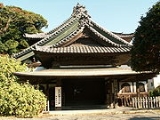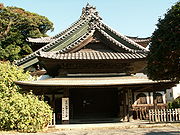
Matsushiro Domain
Encyclopedia

Han (Japan)
The or domain was the name of the estate belonging to a warrior in Japan after the 17th century. The fiefs of the daimyos of the samurai class of Japan during the Edo period were called han.-Edo period:...
of the Edo period
Edo period
The , or , is a division of Japanese history which was ruled by the shoguns of the Tokugawa family, running from 1603 to 1868. The political entity of this period was the Tokugawa shogunate....
, located in Shinano Province
Shinano Province
or is an old province of Japan that is now present day Nagano Prefecture.Shinano bordered on Echigo, Etchū, Hida, Kai, Kōzuke, Mikawa, Mino, Musashi, Suruga, and Tōtōmi Provinces...
. It was ruled for the majority of its history by the Sanada clan
Sanada clan
The was a Japanese clan which rose to prominence in the Sengoku period. During the Edo era, the Sanada ruled the Matsushiro Domain, where they remained until the Meiji Restoration.-Sengoku period:...
.
List of lords
(as Kawanakajima Domain)- Mori clanMori clanThe Mōri clan was a family of daimyō, descended from Ōe no Hiromoto and established themselves in Aki Province. Their name was derived from a shōen in Mōri, Aikō District, Sagami Province. The generation of Hiromoto began to name themselves Mōri.After the Jōkyū War, Mōri was appointed to the jitō...
(TozamaTozamaA ' was a daimyo who was considered an outsider by the rulers of Japan. The term came into use in the Kamakura period and continued until the end of the Edo period.-Edo period:...
; 137,500 kokuKokuThe is a Japanese unit of volume, equal to ten cubic shaku. In this definition, 3.5937 koku equal one cubic metre, i.e. 1 koku is approximately 278.3 litres. The koku was originally defined as a quantity of rice, historically defined as enough rice to feed one person for one year...
)
- Tadamasa
- Matsudaira clanMatsudaira clanThe was a Japanese samurai clan that claimed descent from the Minamoto clan. It first originated in and took its name from Matsudaira village, in Mikawa Province . Over the course of its history, the clan produced many branches, most of which also centered around Mikawa Province...
(ShinpanShinpan (daimyo)The daimyo were certain relatives of the Tokugawa shoguns of Japan. While all shinpan were relatives of the shogun, not all relatives of the shogun were shinpan; an example of this is the Matsudaira clan of the Okutono Domain. The shinpan lords were also known as kamon daimyō — non-daimyo...
; 140,000 kokuKokuThe is a Japanese unit of volume, equal to ten cubic shaku. In this definition, 3.5937 koku equal one cubic metre, i.e. 1 koku is approximately 278.3 litres. The koku was originally defined as a quantity of rice, historically defined as enough rice to feed one person for one year...
)
- TadateruMatsudaira Tadateruwas a daimyo during the Edo period of Japan. He was the sixth son of Tokugawa Ieyasu. He was born in Edo Castle during the year of the dragon , and as a child his name was Tatsuchiyo. His mother was , a concubine of Ieyasu...
(as Matsushiro Domain)
- Matsudaira (Echizen) clanMatsudaira clanThe was a Japanese samurai clan that claimed descent from the Minamoto clan. It first originated in and took its name from Matsudaira village, in Mikawa Province . Over the course of its history, the clan produced many branches, most of which also centered around Mikawa Province...
(ShinpanShinpan (daimyo)The daimyo were certain relatives of the Tokugawa shoguns of Japan. While all shinpan were relatives of the shogun, not all relatives of the shogun were shinpan; an example of this is the Matsudaira clan of the Okutono Domain. The shinpan lords were also known as kamon daimyō — non-daimyo...
; 120,000 kokuKokuThe is a Japanese unit of volume, equal to ten cubic shaku. In this definition, 3.5937 koku equal one cubic metre, i.e. 1 koku is approximately 278.3 litres. The koku was originally defined as a quantity of rice, historically defined as enough rice to feed one person for one year...
)
- TadamasaMatsudaira Tadamasawas a Japanese daimyo of the early Edo period. The 2nd son of Yūki Hideyasu, he succeeded the family headship following his brother Tadanao's forced retirement.He had a magnificent residence constructed outside Edo Castle.-References:...
- Sakai clanSakai clanThe was a Japanese samurai clan that claimed descent from the Nitta branch of the Minamoto clan, who were in turn descendants of Emperor Seiwa. Serata Arichika, a samurai of the 14th century, was the common ancestor of both the Sakai clan and the Matsudaira clan, which the Sakai later served...
(FudaiFudaiwas a class of daimyo who were hereditary vassals of the Tokugawa in Edo period Japan. It was primarily the fudai who filled the ranks of the Tokugawa administration.-Origins:...
; 100,000 kokuKokuThe is a Japanese unit of volume, equal to ten cubic shaku. In this definition, 3.5937 koku equal one cubic metre, i.e. 1 koku is approximately 278.3 litres. The koku was originally defined as a quantity of rice, historically defined as enough rice to feed one person for one year...
)
- TadakatsuSakai Tadakatsu (Shonai)was a Japanese daimyo of the early Edo period. Tadakatsu and his descendants are linked in the history of the han at Tsuruoka in Dewa province....
- Sanada clanSanada clanThe was a Japanese clan which rose to prominence in the Sengoku period. During the Edo era, the Sanada ruled the Matsushiro Domain, where they remained until the Meiji Restoration.-Sengoku period:...
(TozamaTozamaA ' was a daimyo who was considered an outsider by the rulers of Japan. The term came into use in the Kamakura period and continued until the end of the Edo period.-Edo period:...
with de facto fudaiFudaiwas a class of daimyo who were hereditary vassals of the Tokugawa in Edo period Japan. It was primarily the fudai who filled the ranks of the Tokugawa administration.-Origins:...
ranking; 100,000 kokuKokuThe is a Japanese unit of volume, equal to ten cubic shaku. In this definition, 3.5937 koku equal one cubic metre, i.e. 1 koku is approximately 278.3 litres. The koku was originally defined as a quantity of rice, historically defined as enough rice to feed one person for one year...
)
- NobuyukiSanada Nobuyukiwas a Japanese samurai of the Sengoku period. He was the son of daimyo Sanada Masayuki and the older brother of Sanada Yukimura.-Biography:At an early age, Nobuyuki's father served under the daimyo Takeda Shingen and sent Nobuyuki as a hostage to prove the Sanada clan's loyalty to the Takeda clan...
- Nobumasa
- Yukimichi
- Nobuhiro
- Nobuyasu
- Yukihiro
- Yukitaka
- Yukitsura
- Yukinori
- Yukitami

